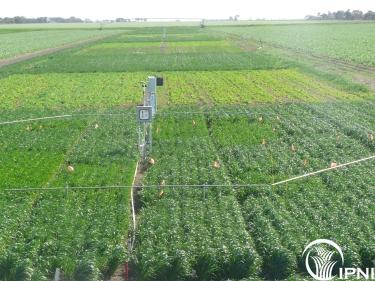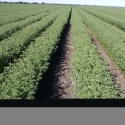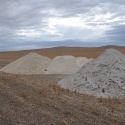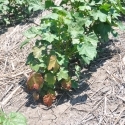04 Sep 2013
Elevated Carbon Dioxide and Wheat Nutrition
Papers presented at the 2013 IPNC, Turkey and the ANZ Fertilizer Industry Conference
 FACE Experiment Site, 2008
FACE Experiment Site, 2008
Crop N & P demand under climate change
RM Norton
International Plant Nutrition Institute, Australia & New Zealand.
SUMMARY
Rising atmospheric carbon dioxide concentration will result in drier and warmer conditions across much of the mid-latitudes, including Australia and New Zealand. Research at the Australian Grains Free Air Carbon Dioxide facility has shown that although yield increased due to improved C supply, wheat grain protein, baking quality and important micronutrients all decline.
Future farming systems will require cultivars adapted to higher carbon dioxide levels and new combinations of nutrient source, rate, time and place to meet the change in the pattern of nutrient demand.
INTRODUCTION
Atmospheric carbon dioxide (CO2) has been rising since the industrial revolution, and at the present rate will reach about 550 μmol mol-1 by 2050. This increase, along with the consequent perturbations of climate will profoundly influence food production and farming systems. Higher CO2 levels are generally reported to stimulate growth in C3 plants. Uncertainty about how this increase would interact with hotter and drier growing conditions led to the establishment of the Australian Grains Free Air Carbon Dioxide Enrichment (AGFACE) facility in 2007. We provide an overview of the results from the AGFACE research group relating to wheat crop nutrition.
METHODS
The AGFACE facility is at Horsham (36.7519oS, 142.1144oE) in southeastern Australia. The facility has 8 elevated CO2 FACE rings (~550 μmol mol-1) and 8 control (~385 μmol mol-1) rings with 12 m rings and 12 plots each 4 m by 1.7 m per ring (2007/2008) or 16 m rings wth 24 plots (after 2009). These main CO2 effects are combined with different water supply (by irrigation), temperature during grain fill (by altering sowing time), nitrogen (by fertilizer) and cultivar. CO2 was injected over the crop in open-air rings from emergence until maturity in 2007, 2008 and 2009 (Mollah et al. 2009). Growth, yield, water use, grain mineral content and yield have been measured for each of the treatments and these data analysed as a factorial analysis of variance.
RESULTS and discussion
Growth and Yield
Elevated CO2 increased crop biomass at maturity by 22% (2007), 31% (2008) and 32% (2009). Mean grain yield of two common wheat cultivars (Yitpi and Janz) increased on average from 252 g m-2 to 322 g m-2 when grown under elevated CO2 (Table 1). Sowing time and additional water affected growth and yield with the later sowing showing no response to higher CO2 in one of the three years (2008.) In two of three years, kernel weight increased with higher CO2 although there was no consistent change in other yield components (Norton et al. 2010).
The increase in growth generally occurred during the spring rather than the cooler winter months. An important outcome of the research is that the stimulation occurs in most situations, even under warmer and drier climates. Harvest index – the ratio of grain to growth was not affected under eCO2 but the drier and hotter conditions are likely to adversely affect this ratio leading to crops “haying off” (Nutall et al. 2012).
Increased nutrient demand
When grown under elevated CO2, plants had lower tissue N content particularly later in growth, but there were few interactions with temperature, water or cultivar. For example, in 2008 leaf N concentration at flowering declined from 3.8% to 3.5% (p<0.00) (Norton et al. 2010) although the lower leaf N content did not compromise photosynthetic capacity as the main photosynthetic enzyme (RubisCo) activity increased (Thilikarthne et al. 2013).
Grain protein at maturity declined significantly in nearly all situations under elevated CO2 (Table 1). Fernando et al. (2012) showed in one cultivar that protein declined from 15.5% to 13.5%. It is important to understand the mechanism behind this change, so that new cultivars and management systems can be designed to minimise this decrease. For example, Fernando (2013) showed that wheat supplied with ammonium-N showed a smaller protein decline as those supplied with nitrate-N.
Despite this, the demand for N increased due to the stimulation of growth, which may be a consequence of reduced plant N causing less remobilisation from the leaves to the grain during grain filling. When averaged across all the experimental treatments, elevated CO2 increased crop N removal by 20% (Lam et al. 2012). This indicates that added N will be required by crops growing in future carbon dioxide rich climates.
Table 1. The effect of elevated CO2 on the grain yield and grain N content of wheat from the AGFACE experiment. All means within a year are significantly different (p<0.05).
| Factor | [CO2] (μmol/mol) | 2007 | 2008 | 2009 |
| Grain yield (g m-2) | 380 | 258 | 247 | 252 |
550 | 323 | 310 | 332 | |
| Grain N content (%) | 380 | 2.44 | 3.16 | 3.06 |
550 | 2.33 | 3.04 | 2.81 |
Elevated CO2 did not affect the efficiency at accessing fertilizer N, and in the AGFACE there was no evidence of differences in N mineralisation from crop residues (Lam et al. 2012a). Nitrogen fixation efficiency was not affected by eCO2, but legume growth stimulation meant that more N was derived from biological N fixation under elevated CO2 This response was dependant on an adequate P supply to the legume (Lam et al. 2012b). The relative value of legume derived N to subsequent cereals may be reduced under elevated CO2. However, compared to N fertilizer application, legume incorporation will be more beneficial to grain yield and N supply to subsequent cereals under future climates (Lam et al. 2013). There is no evidence that crops grown under eCO2 have a higher efficiency of P uptake or access to different soil P pools (Jin et al. 2013a). This was despite more microbial activity around the roots of plants under eCO2, probably due to increased production of root exudates (Jin et al. 2013b).
Concentration of grain S, Ca, Zn and Fe decreased in wheat grown under elevated CO2. This could not be fully explained by “yield dilution and the N:S ratio also declined (Fernando et al. 2012). As well as changing the amount of grain protein, the types of proteins also changes, which affects baking quality. The reduction in grain protein was correlated with Fe, Zn, and S concentration, so that elevated CO2 is likely to exaggerate worldwide Fe and Zn malnutrition for those on grain-based diets, although lower grain phytate concentrations may offset some of this decline (Fernando et al. 2012).
Climate impacts on future nutrient demand
It is difficult to upscale these results to national or international levels, as there are other challenges facing agricultural production most importantly the need to increase food quantity and quality to the extra 2 billion people by 2050, which at the same time ensuring a clean and healthy environment. These issues are not mutually exclusive, and good agricultural practice has positive outcomes for both production and the environment.
With current C3 crops, 2050 atmospheric [CO2] could increase N demand by 20%, and that higher N demand will require balanced nutrition with extra P, K, S and micronutrients.
CONCLUSIONS
This research identified that nutrient management strategies will need review under elevated CO2. The pattern of growth, and therefore the temporal pattern of nutrient demand mean new combinations of the nutrient source, rate, time, and place will be needed, along with more efficient cultivars.
Most important will be development of strategies to stop protein changes and so maximize the benefits of the extra carbon available. This may be by changing to ammonium based N sources, use of foliar N around grain filling and by building on the current research that is developing more N efficient cultivars.
ACKNOWLEDGEMENTS
This research is supported by the Australian Government, Grains Research and Development Corporation, the Victorian Department of Primary Industries and The University of Melbourne. The research reported here was the work of my colleagues S.K. Lam, S. Seneweera, N. Fernando, S. Tausz-Posch, M Tausz and D. Chen (University of Melbourne) and R. Armstrong, J. Nuttall, G O’Leary and G. Fitzgerald (Victorian Department of Environment and Primary Industries).
REFERENCES
Fernando, N., et al. (2012) Food Chemistry, 133, 1307-1311.
Fernando, N. (2013)
Jin, J. et al. (2013a) Plant and Soil, August 2013, published on-line.
Jin, J. et al. (2013b) Plant Soil, 368, 315-328.
Lam, S.K., et al. (2012a) Nut. Cyc. Agroecosys., 92, 133-144.
Lam, S.K., et al. (2012b) Crop Pasture Sci. 63, 53-62.
Lam, S.K., et al. (2013) Plant Soil, 364, 81-91.
Mollah, M. et al. (2009) Crop Pasture Sci. 60 (8), 697-707.
Norton, R., et al. (2010) 8th International Wheat Conference Abstracts, 1-4 St Petersburg, Russia (Ed NI Dzyubenko). p142-143.
Nuttall, J. et al. (2012) Crop Pasture Sci. 63:595-605.
Thilakarathne, L., et al. (2013) Funct. Plant Biol. 40, 185-194.
Additional Resources
IPNC Presentation PDFSize: 1.68 MB
IPNC Conference PaperSize: 2.9 MB
ANZFIC Presentation PDFSize: 2.08 MB
ANZFIC Conference PaperSize: 0.09 MB





